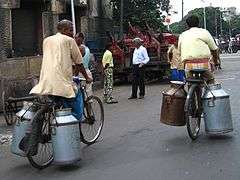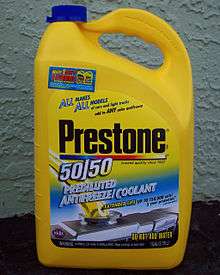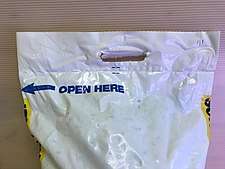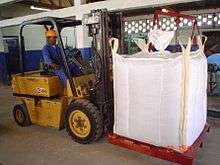Package handle
Package handles, or carriers, are used to help people use packaging. They are designed to simplify and to improve the ergonomics of lifting and carrying packages[1][2][3]. Handles on consumer packages add convenience and help facilitate use and pouring. The effect of handles on package material costs and the packaging line efficiencies are also critical. A handle can be defined as “an accessory attached to a container or part for the purpose of holding or carrying.”[4] Sometimes a handle can be used to hang a package for dispensing or use.
.jpg)
Handles can be built into a package, sometimes in the form of hand holes or hand holds. They can also be attached to a finished complete package after filling and closing, or even at the point of purchase.
The performance and design criteria for handles are often detailed in a contract or specification. For example handles for some US government containers are specified in Mil-Std-648.[5]
History
People have long seen a need to have package forms which are easy for people to carry and to use. Some of these, such as amphora[6], date from the Neolithic period.
 Amphora with built in handles
Amphora with built in handles Man carrying a wooden box or chest, 1625
Man carrying a wooden box or chest, 1625_-_NARA_-_541753.tif.jpg) Man carrying a jug, Portugal, 1950
Man carrying a jug, Portugal, 1950 Jerrycans of fuel. 1941
Jerrycans of fuel. 1941 Handles on metal milk churns allow easy carrying
Handles on metal milk churns allow easy carrying Stoneware jug
Stoneware jug
Boxes
Wooden boxes often have metal handles nailed or otherwise attached to the ends to facilitate handling. Steel boxes also frequently have attached handles or hinged bails.
Corrugated boxes can have hand holes die-cut into the ends to assist material handling tasks.[7] Several designs are in use.[8][9] Care must also be taken for the hand holes not to weaken the strength of the box.[10][11][12]
Depending on the contents and the degree of handling required, reinforcement is sometimes needed to prevent tearing. Reinforcing tapes, whether pressure -sensitive or heat-activated, can be applied to boxes in the vicinity of hand holes.[13][14]
Separate plastic or composite fitments are also available for corrugated boxes.[15][16]
 Telescope box used for bananas. Note hand holes and ventilation holes
Telescope box used for bananas. Note hand holes and ventilation holes Partial overlap box; minor flaps fold down to provide double thickness of corrugated board
Partial overlap box; minor flaps fold down to provide double thickness of corrugated board Handles on a metal ammunition box
Handles on a metal ammunition box.jpg) Boxes of Greek laundry detergent with handles
Boxes of Greek laundry detergent with handles Corrugated tray of tomatoes at a farmers market
Corrugated tray of tomatoes at a farmers market- Box wine with a plastic handle inserted into holes in the top of the corrugated box
Plastic bottles
Many plastic containers have built in handles. Plastic shipping containers and storage tubs often have handles molded into them. Consumer blow molded containers often have integral handles or are shaped to facilitate grasping.[17][18]
 Bottle of antifreeze
Bottle of antifreeze bulk soy sauce
bulk soy sauce- Blow molded plastic bottle of milk with indentations for a handle
 HDPE plastic bottle of milk
HDPE plastic bottle of milk large plastic bottles of water
large plastic bottles of water Drain cleaner
Drain cleaner
Ssparate handles are sometimes added to a bottle, usually around the neck at the closure. Several methods have been developed.[19] [20] [21] [22] [23]
 apple juice
apple juice water
water Clip used to join two spray bottles and to provide a handle
Clip used to join two spray bottles and to provide a handle
Bags
Many types of bags have handles to assist in carrying them.
.jpg) Reusable fabric shopping bag with handles
Reusable fabric shopping bag with handles Kraft paper bags with handles
Kraft paper bags with handles- A blue reusable shopping bag
 Plastic bag of water softener salt; handle die-cut through the thick plastic to allow carrying
Plastic bag of water softener salt; handle die-cut through the thick plastic to allow carrying FIBC: bulk bag with lifting straps
FIBC: bulk bag with lifting straps
Multi-packs of beverage containers
Shrink wrapped Multi-packs often have open ends (bulls eyes) which can be used as handles. Methods are available to reinforce the film, if needed.[24][25] Handles are often used on beverage carriers.
 Shrink wrapped pack of bottles with ends (bulls eyes) as handles
Shrink wrapped pack of bottles with ends (bulls eyes) as handles Six pack rings for beverage cans
Six pack rings for beverage cans Paperboard basket
Paperboard basket- Plastic six-pack carrier
Tape handle

Pressure sensitive tape is often used as a handle: filament tape or strong film backed tapes (polypropylene or polyester). A loop can be applied over a package with paper or film used to cover the adhesive in the center portion. Another example with a shrink film package is for a tape to be applied to a film with slits cut in the film on either side of the tape. When the film shrinks, the tape does not and a handle is formed.[26] PSA tape handles can be built into the package structure or can also be added after package completion.[27] Specialized application machinery is sometimes available.[28]
Bail handle
A bail handle consists of an open loop with ends attached to the item or package, sometimes to fixed mounts or ears. Several designs are available: bails are typically made of metal (wire) or plastic. It is a type of package handle which may be used for carrying or hanging items such as cans, pails, or jars.
Testing
Several package testing options are available to packaging engineers to help determine the suitability of package handles.
People can be used directly in an evaluation. Several different people can carry (and even abuse) handle and package options for subjective ratings. These can be compiled in a report.[29]
More objective laboratory procedures are also used. Fixtured ‘’hands’’ of various designs are used to hold a handle (sometimes two handles for a box). ASTM International D6804, Standard Guide for Hand Hole Design in Corrugated Boxes, describes “jerk testing’’ by modified drop test procedures or use of the constant pull rates of a Universal testing machine. ASTM F852, Specification for Portable Gasoline, Kerosene, and Diesel Containers for Consumer Use, requires severe "jerk testing" of the handle. These test procedures are also used on other types of packages.[30][31] Other test procedures are conducted with a static force by hanging a heavily loaded package for an extended time or even using a centrifuge.
See also
References
- Ergonomic Guidelines for Manual Material Handling (PDF), California Department of Industrial Relations, 2007, p. 32, retrieved April 2, 2019
- Davis, K G (1998). "Reduction of spinal loading through the use of handles" (PDF). Ergonomics. 41 (8): 1155–1168. doi:10.1080/001401398186450. PMID 9715674. Retrieved March 23, 2019.
- Wang, Mao-Jiun J. (Winter 2000). "The Effect of Handle Angle on MAWL, Wrist Posture, RPE, and Heart Rate". Human Factors: 553–565. CiteSeerX 10.1.1.1000.7796.
- Soroka, W (2008). Glossary of Packaging Terminology. IoPP. p. 103. ISBN 978-1-930268-27-2.
- MIL-STD-648D, DEPARTMENT OF DEFENSE DESIGN CRITERIA STANDARD, SPECIALIZED SHIPPING CONTAINERS (PDF), 10 April 2008, pp. section 4.17, retrieved 26 April 2018
- Twede, D (2002), "Commercial Amphoras: The Earliest Consumer Packages?", Journal of Macromarketing, 22 (1): 98–108, doi:10.1177/027467022001009, retrieved 19 June 2019
- Nogueira, H C (2018). "Adding Handles to Optimize Manual Box Handling". BioMed Research International. 2018: 7315217. doi:10.1155/2018/7315217. PMC 6276528. PMID 30581864.
- ASTM D6804 Standard Guide for Hand Hole Design in Corrugated Boxes, ASTM International, 2015
- US3094268A, Swanson, "Carrying handle construction for cartons", published 1963
- Han, Jongkoo; Park (January 2007). "Finite element analysis of vent/hand hole designs for corrugated fibreboard boxes". Packaging Technology and Science. 20 (1): 39–47. doi:10.1002/pts.741.
- Singh, J (2008), "The Effect of Ventilation and Hand Holes on Loss of Compression Strength in Corrugated Boxes", J Applied Packaging Research, 2 (4): 227–238, retrieved 2 April 2018
- US4037777A, Maughan, "Handhole closure for containers", published 1977
- US4567070A, Karass, "Fibrous material reinforcing tape, method of making the same and containers reinforced by said tape", published 1986
- US4817866A, Wonnacott, "Packaging", published 1989
- US20040007612A1, Johansen, "Box hand hole reinforcement and method of use", published 2004
- US3774836A, Nunn, "Carton having tape handle", published 1973
- Birkby, David (May 2014). "PET bottle handle—N.A. success story". Canadian Packaging. Retrieved 29 May 2018.
- Widiyati, Khusnun (2013). "The Ease of Grasping to Evaluate Aesthetically Pleasing PET Bottle Design". Journal of Advanced Mechanical Design, Systems, and Manufacturing. 7 (5): 849–861. doi:10.1299/jamdsm.7.849. Retrieved April 1, 2019.
- EP0026557A1, Newman, "Combination of a carrier assembly and a pair of containers", published 1979
- US4509639A, Thompson, "Multi-container carrier package and a method of assembly therefor", published 1985
- US4093295A, Erickson, "Bottle carrier", published 1975
- US4257525A, Thompson, "Bottle with attached handle", published 1979
- US5788302A, Barrash, Ferguson, "Bottle carrier", published 1997
- US7775349B2, Walker, "Shrink-wrap packaging incorporating reinforced integral handle", published 2010
- US20070215504A1, Walker, "Shrink-wrap packaging incorporating reinforced integral handle", published 2007
- US4700528A, Bernard, "Heat shrink package handle", published 1987
- US6647649B2, Lawrence, "Pressure-sensitive adhesive tape handle construction", published 1962
- US5186542A, Siebold, "Tape handle for a container and method for construction thereof", published 1992
- Diringer, J. A. (2016). Evaluation of Durability of Nonwoven Polypropylene Grocery Bags Under Routine Use (MSc). Clemson University. Retrieved April 2, 2019.
- US4269322A, Larson, "Flexible bail assembly", published 1980
- Diringer, J. A. (2016). Evaluation of Durability of Nonwoven Polypropylene Grocery Bags Under Routine Use (MSc). Clemson University. Retrieved April 2, 2019.
Further reading
- Yam, K. L., "Encyclopedia of Packaging Technology", John Wiley & Sons, 2009, ISBN 978-0-470-08704-6